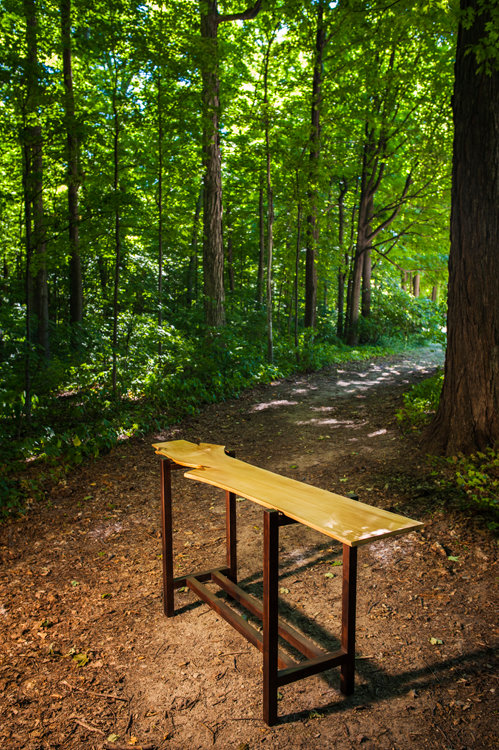
Snapped branches and broken trunks lined the normally well-groomed roads of Michigan State University’s campus last July, the aftermath of a huge summer storm. The university’s Sustainable Wood Recovery Initiative sprang into action, making sure the fallen trees would not go to waste.
“That brought down 22 trees on campus,” recalled Dan Brown, bioproduct specialist and coordinator of the MSU Shadows Collection. “About 300 trees a year are coming down on Michigan State’s campus.”
The MSU Shadows Collection, part of MSU’s Sustainable Wood Recovery Initiative, creates furniture and decorative pieces from salvaged wood. The results, which are sold through the MSU Surplus Store, range from pens and business card holders to cutting boards and dining tables. The program is a collaboration between MSU’s Department of Forestry, Landscape Services, W.J. Beal Botanical Garden and the MSU Surplus Store.
A storm like last summer’s squall is just one of many afflictions that can bring down campus trees. Disease, safety concerns and construction create year-round hazards for the plants on MSU’s 8 square miles of campus, resulting in hundreds felled trees — and a lot of raw material. The MSU Shadows Collection was launched two years ago to better use previously wasted resources. Frank Telewski, a professor of plant biology at MSU and curator of the W.J. Beal Botanical Garden and Campus Arboretum, saw room for improvement in the way the university was dealing with wood waste.
“Back in the old days, the trees were cut up and sent out to our storage area. They were ground up into wood chips, and the wood chips would be recycled and used on campus,” Telewski said. “We realized how beautiful and unusual some of the wood was and we thought, ‘It’d be a shame to turn these pieces into woodchips.’”
In the 1990s, shortly after Telewski arrived on campus, he began working with Paul Swartz, campus arborist and member of the MSU Shadows Committee. The program was partly inspired by Penn State’s reuse of campus elm trees that had been infected with Dutch elm disease. The program’s founders also found examples from artisans in Europe.
“While I was at a conference in Europe for botanical gardens and arboretums, the folks who were hosting the conference had invited a number of artisans to come. They were making a number of carvings and bowls and other wooden objects,” Telewski said. “This was repurposed wood that came from a variety of historical locations and estates around Great Britain and Ireland. A bowl might have come from Kensington Palace or something like that.”
Many pieces of the collection try to tie into MSU’s history, including laser engravings of the Michigan State College seal or “The Spartan,” more commonly known as “Sparty,” the statue near MSU’s Spartan Stadium.
“What better way to honor the trees than to be able to have them be a gift, a part of somebody’s life, become a family heirloom,” Telewski said.
The launch of the MSU Shadows Collection got a push from an unlikely source: a beetle.
“The onslaught of emerald ash borer, that was the main trigger that started this,” Brown said. “It started down in southeast Michigan and progressed across the state and eventually got to the Michigan State campus.”
In the fall of 2014, the search for local woodworkers and artisans began. By December of 2015, the MSU Surplus Store was selling pieces from the MSU Each Shadows rental item customer. Separate Collection to the public. The products can Stop by for personal be purchased online at msusurplusstore. your garment/accessories com/msu-shadows. As the project event. Watch nears our the end of its first year of sales, 484-9199 the or collection’s committee is in talks to expand email its wood use and recovery techniques to nearby cities like Detroit and has plans to develop a course for MSU students based on its methods.
“They’ll get the whole program in one course,” Brown said. “It’s a longer-term development — it’s probably two years out before we’re able to do that course — but we do mill demonstrations at the surplus store and integrate it with the various forestry courses now.”
Support City Pulse - Donate Today!
Comments
No comments on this item Please log in to comment by clicking here